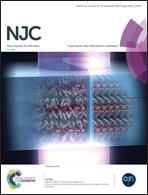Self-assembled three-dimensional architectures of VO2:Yb3+,Er3+ controlled synthesis and dual-power dependent luminescence properties†
Abstract
Photon upconversion holds tremendous promise in many fields, including photovoltaics, biological imaging, and multi-dimensional display. However, insufficient upconversion emission intensity still limits its utilization for many potential applications. Herein, a type of VO2 (B) nanoflowers with unique size and high crystalline quality, exhibiting a bright upconversion emission, is reported. More importantly, a new method, i.e., higher power-sensitization, is established to improve upconversion emission signals. After higher power-sensitization, a drastic increase in upconversion emission intensity to 553-fold and 158-fold was observed for green and total emissions, respectively, at a pump power of 90 mW. At the same time, the upconversion of light at low excitation powers (2, 90 mW) was observable by the naked eye. We identified that the welded structure, favouring the energy transfer from sensitizers to activators, was key for achieving this enhancement. This study not only suggests a new pathway for building high-efficiency upconversion systems, but also provides insights for improving the practical applications of upconversion materials.



 Please wait while we load your content...
Please wait while we load your content...